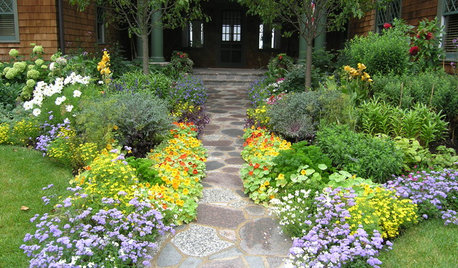Please help with planting dates
Whit301
9 years ago
Related Stories

GARDENING GUIDESGreat Design Plant: Silphium Perfoliatum Pleases Wildlife
Cup plant provides structure, cover, food and water to help attract and sustain wildlife in the eastern North American garden
Full Story
HOUZZ TOURSMy Houzz: DIY Love Reforms a Dated Cape Ann Home
Handmade touches and classic neutrals transform a dark Massachusetts house into a beautiful home fit for a family
Full Story
GARDENING GUIDESGreat Design Plant: Ceanothus Pleases With Nectar and Fragrant Blooms
West Coast natives: The blue flowers of drought-tolerant ceanothus draw the eye and help support local wildlife too
Full Story
GARDENING GUIDESGreat Design Plant: Snowberry Pleases Year-Round
Bright spring foliage, pretty summer flowers, white berries in winter ... Symphoricarpos albus is a sight to behold in every season
Full Story
GARDENING GUIDESPathway Plantings That Please the Senses
Add some color, life and intrigue beside your sidewalk with these 7 suggestions
Full Story
GARDENING GUIDES8 Unthirsty Plants Help You Save Water in Style
Spend less effort and money on your landscape with drought-tolerant and native plants that liven up your yard
Full Story
HOUZZ TOURSMy Houzz: From Dated to Dreamy in 3 Weeks
The results belie the speedy makeover of this 1940s Quebec home — which not even a colony of ants could derail
Full Story
BATHROOM COLOR6 Bathroom Color Schemes That Will Never Look Dated
If you’d love to splash some color around your bathroom but fear it won’t stand the test of time, stick with these fail-safe combos
Full Story
BATHROOM DESIGNFrom Dated Southwestern to Serene Minimalism in a Cleveland Bathroom
Natural materials, clean lines and a reconfigured layout bring on moments of Zen in an Ohio couple's renovated bath
Full StorySponsored
Your Industry Leading Flooring Refinishers & Installers in Columbus
More Discussions







chickencoupe
Okiedawn OK Zone 7
Related Professionals
Lowell Landscape Architects & Landscape Designers · Roosevelt Landscape Architects & Landscape Designers · Dixon Landscape Contractors · Galveston Landscape Contractors · Midland Landscape Contractors · Paramus Landscape Contractors · Peachtree City Landscape Contractors · Spring Landscape Contractors · Tehachapi Landscape Contractors · Raytown Landscape Contractors · Beavercreek Decks, Patios & Outdoor Enclosures · Fishers Decks, Patios & Outdoor Enclosures · Rantoul Decks, Patios & Outdoor Enclosures · Riverside Decks, Patios & Outdoor Enclosures · Windsor Decks, Patios & Outdoor EnclosuresWhit301Original Author
Whit301Original Author
chickencoupe
Okiedawn OK Zone 7
Whit301Original Author
Whit301Original Author
Okiedawn OK Zone 7
Whit301Original Author
Okiedawn OK Zone 7